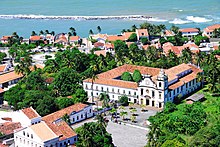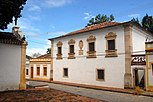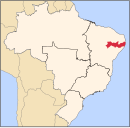Олинда
Олинда | |
|---|---|
| Муниципалитет Олинды | |
 Location in Pernambuco | |
| Coordinates: 8°0′32″S 34°51′18″W / 8.00889°S 34.85500°W | |
| Country | |
| Region | Northeast |
| State | |
| Founded | March 12, 1535 |
| Incorporated (as village) | 1537 |
| Incorporated (as city) | 1676 |
| Government | |
| • Mayor | Lupércio Carlos do Nascimento (Solidariedade) |
| Area | |
| • Municipality | 43.55 km2 (27.1 sq mi) |
| • Metro | 2,768 km2 (1,068.7 ;) sq mi) |
| Elevation | 16 m (52 ft) |
| Population (2020 [1]) | |
| • Municipality | 393,115 |
| • Density | 5.660/km2 (14.659/sq mi) |
| • Metro | 3,768,902 |
| Time zone | UTC−3 (BRT) |
| HDI (2010) | 0.735 – high[2] |
| Website | www |
Олинда ( Португальское произношение: [ɔˈlĩdɐ] ) является историческим городом в Пернамбуко , Бразилия, в северо -восточном регионе . побережье страны Он расположен на северо -восточном атлантическом океаническом , в столичном регионе Ресии . , столицы штата [ 3 ] Население насчитывает 393 115 человек, охватывает 41,681 квадратных километров (16,093 кв. МИ) и имеет плотность населения 9 437 жителей на квадратный километр (24 440/кв. Миль). Это отмечено как один из наиболее сохранившихся колониальных городов в Бразилии [ 4 ] и был заселен с 1535 года.
Будучи бывшей столицей капитана Пернамбуко в колониальную эпоху , у Олинда много исторических зданий - центр был объявлен ЮНЕСКО местом Всемирного наследия в 1982 году - и богатой культурой. Карнавал Олинда, популярная уличная вечеринка, очень похожа на традиционные португальские карнавалы с добавлением танцев с африканскими влияниями, отражающими историю северо -востока. Все праздники отмечаются на улицах без трибунов или веревки, и, в отличие от других городов, вход бесплатный. Во многих жанрах есть сотни небольших музыкальных групп (иногда с одним исполнителем).
History
[edit]
| UNESCO World Heritage Site | |
|---|---|
 View of Olinda | |
| Criteria | Cultural: ii, iv |
| Reference | 189 |
| Inscription | 1982 (6th Session) |
| Area | 120 ha |
| Buffer zone | 920 ha |
Several indigenous tribes occupied the coast of Northeastern Brazil for several thousand years, and the hills of the present day municipality of Olinda had settlements of Caetés and Tupinambá tribes, which were frequently at war. French mercenaries are thought to be the first Europeans to reach the region, but the Portuguese exploited intertribal rivalries and managed to build a stronghold on the former Caeté village on a high hill. Recent studies by the Federal University of Pernambuco have uncovered new evidence of the pre-colonial population of the area.
The settlement of Olinda was founded in 1535 by Duarte Coelho Pereira, from Portugal; it was elevated to a town on March 12, 1537.[3] It was made the seat of the Roman Catholic Territorial Prelature of Pernambuco in 1614, becoming the Diocese of Olinda in 1676. The economy of the region was dominated by the production of sugarcane. This, combined with the importing of slaves from Africa to support cultivation made Olinda a colonial stronghold.
Olinda was the capital of the Portuguese hereditary captaincy of Pernambuco, but was burned by Dutch invaders. The Portuguese built their town on the hill, for practical purposes (eg, sewers) and to make it easier to defend. In the 17th century the Kingdom of Portugal was united with Spain (the 1580-1640 Iberian Union). Taking advantage of this period of Portuguese weakness, the area around Olinda and Recife was occupied by the Dutch who gained access to the Portuguese sugarcane plantations.[4] John Maurice, Prince of Nassau-Siegen was appointed as the governor of the Dutch possessions in Brazil in 1637 by the Dutch West India Company on recommendation of Frederick Henry. He landed at Recife, the port of Pernambuco and the chief stronghold of the Dutch, in January 1637. By a series of successful expeditions, he gradually extended the Dutch possessions from Sergipe on the south to São Luís de Maranhão in the north. He likewise conquered the Portuguese possessions of Saint George del Mina, Saint Thomas, and Luanda, Angola, on the west coast of Africa. After the dissolution of the Iberian Union in 1640, Portugal would reestablish its authority over the lost territories of the Portuguese Empire, including the former Dutch Brazil. Sugarcane plantation slavery would continue to be a source of wealth in Olinda until the Lei Áurea ("Golden Law") abolished slavery in an independent Brazil in 1888.
Olinda declined in importance after the Dutch invasion. Recife became the capital of Pernambuco in 1827, and Olinda is part of the greater Recife metropolitan area. Due to the historic position of the city, its cathedral, a World Heritage Site, called São Salvador do Mundo, remains the primary seat of the Roman Catholic Archdiocese of Olinda and Recife,[3] with a co-cathedral in Recife. Olinda also has a Minor Basilica, again a World Heritage Site (Minor): Basílica Abacial do Mosteiro de São Bento de Olinda.[5]
Besides its natural beauty, Olinda is also one of Brazil's main cultural centers: in 1982 it was declared a World Heritage Site by UNESCO. The city relives the magnificence of the past every year during the large Carnival, to the rhythms of frevo, maracatu and other northeast music and dances.
Geography
[edit]Olinda is located on the coast of the state of Pernambuco, six kilometers north of the center of Recife. It is bordered by the Atlantic Ocean to the east, the municipality of Paulista to the north, and Recife to the south and west. It is part of the Metropolitan Region of Recife (RMR).
The average elevation is 16 m above sea level. The landscapes is made of plains and hills, some of them steep. Olinda is mostly drained by the Paratibe River (55.13% of the territory), with the remainder drained by the Capibaribe River.[6] The municipality is in the Atlantic Forest ecoregion.
Olinda has a tropical monsoon type climate (Köppen-Geiger: Am), typical of the eastern section of the northeastern Brazilian coast, with average monthly temperatures consistently above 18 °C, little diurnal variation in temperature, abundant rainfall most of the year, and high relative humidity.[7]
Economy
[edit]

The main economic activities in Olinda are based in tourism, commerce, transportation industry and artcraft. The tourist sector has a boom every Carnival when thousands of people are in the old historic town center.
Economic indicators
[edit]| Population | GDP x(1000 R$).[8] | GDP pc (R$) | PE | RMR |
|---|---|---|---|---|
| 397,268 | 2,179,183 | 5,567 | 3.54% | 5.39% |
Economy by Sector
| Primary sector | Secondary sector | Service sector |
|---|---|---|
| 0.17% | 18.70% | 81.13% |
Gallery
[edit]Historic Center
[edit]-
One of the roads of the historic center
-
A church in the historic center
-
Distant view of historic center with sea behind
See also
[edit]Ссылки
[ редактировать ]- ^ Ibge 2020
- ^ «Архивная копия» (PDF) . Программа развития Организации Объединенных Наций (ПРООН). Архивировано из оригинала (PDF) 8 июля 2014 года . Получено 1 августа 2013 года .
{{cite web}}: CS1 Maint: архивная копия как заголовок ( ссылка ) - ^ Jump up to: а беременный в "Олинда" . Энциклопедия Британская . Чикаго, штат Иллинойс: Encyclopaedia Britannica, Inc.
- ^ Jump up to: а беременный «Пернамбуко, Олинда» (по португальскому). Бразильский институт географии и статистики. 2016 Получено 12 августа 2016 года .
- ^ «Архиепархия Олинда Е -Рек, Бразилия» .
- ^ Олинда, Секретариат Secom общения. «Олинда в данных» . МАТНИКА ОЛИНДА, больше достижений для всех (на бразильском португальском) . Получено 17 апреля 2021 года .
- ^ « Холмы столичного региона Ресии » . Агентство Pernambuco Государственного планирования и исследований (Condepe/Fidem) . Архивировано с оригинала 2 апреля 2015 года . Получено 1 мая 2014 года .
- ^ Olinda 2007 ВВП IBGE Page 31 Архивировал 2016-03-04 на машине Wayback
Внешние ссылки
[ редактировать ]![]() Olinda Travelda Guide от Wikivoyage
Olinda Travelda Guide от Wikivoyage
- Официальный сайт мэрии
- Официальный сайт городского совета
- Исследуйте исторический центр города Олинда в коллекции ЮНЕСКО в Google Arts and Culture
- https://web.archive.org/web/20130407002251/http://olindavirtual.org/
- https://web.archive.org/web/20060614045202/http://www.olinda.com.br/ Коммерческий сайт
- Видео Olinda, Pernambuco (PT) [1]
- Видео Олинда улица Карнавал [2]
- Олинда
- Заселенные места, установленные в 1535 году
- Места всемирного наследия в Бразилии
- Исторические районы
- Заселенные прибрежные места в Пернамбуко
- 1535 заведения в Бразилии
- Муниципалитеты в Пернамбуко
- 1630 заведения в голландской империи
- Заселенные места, созданные голландской западной индийской компанией
















